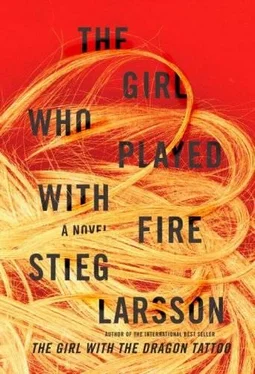Blomkvist sat motionless, staring at Bublanski.
“I’ll put it another way,” Bublanski said. “We were looking for a connection between Salander and the couple in Enskede. It turns out that you not only discovered the victims, you are also the connection. Do you have anything to say to this?”
Blomkvist leaned back, closed his eyes, and tried to make heads or tails of the situation. Salander suspected of murdering Svensson and Johansson? That can’t be right. It doesn’t make sense. Was she capable of murder? Blomkvist suddenly saw in his mind’s eye her expression from two years ago when she had gone after Martin Vanger with a golf club. There was no shadow of doubt that she could have killed him. But she didn’t, because she had to save my life. He unconsciously reached for his neck, where Vanger’s noose had been. But Svensson and Johansson … it doesn’t make any logical sense whatsoever.
He was aware that Bublanski was watching him closely. Like Armansky, Blomkvist had to make a choice. Sooner or later he would have to decide which corner of the ring he was going to be in if Salander was accused of murder. Guilty or not guilty?
Before he managed to say anything, the telephone on Berger’s desk rang. She picked it up, listened, then handed the receiver to Bublanski.
“Somebody called Faste wants to speak to you.”
Bublanski took the receiver and listened attentively. Blomkvist and Berger could see his expression change.
“When are they going in?”
Silence.
“What’s the address again? Lundagatan. And the number? OK. I’m in the vicinity. I’ll drive there.”
Bublanski stood up.
“Excuse me, but I’ll have to cut this conversation short. Salander’s guardian has just been found shot dead. She’s now being formally charged, in absentia, with three murders.”
Berger’s mouth dropped open. Blomkvist looked as if he had been struck by lightning.
The occupation of the apartment on Lundagatan was an uncomplicated procedure from a tactical perspective. Faste and Andersson leaned on the hood of their car keeping watch while the armed response team, supplied with backup weapons, occupied the stairwell and took control of the building and the rear courtyard.
The team swiftly confirmed what Faste and Andersson already knew. No-one opened the door when they rang the bell.
Faste looked down Lundagatan, which was blocked off from Zinkensdamm to Högalid Church, to the great annoyance of the passengers on the number 66 bus.
One bus had been stuck inside the barriers on the hill and could not go forward or back. Eventually Faste went over and ordered a patrolman to step aside and let the bus through. A large number of onlookers were watching the commotion from upper Lundagatan.
“There has to be a simpler way,” Faste said.
“Simpler than what?” Andersson said.
“Simpler than sending in the storm troopers every time a stray hooligan has to be brought in.”
Andersson refrained from commenting.
“After all, she’s less than five feet tall and weighs about ninety pounds.”
It had been decided that it was not necessary to break down the door with a sledgehammer. Bublanski joined them as they waited for a locksmith to drill out the lock, and then he stepped aside so that the troops could enter the apartment. It took about eight seconds to eyeball the 500 square feet and confirm that Salander was not hiding under the bed, in the bathroom, or in a wardrobe. Then Bublanski was given the all clear to come in.
The three detectives looked with curiosity around the impeccably kept and tastefully furnished apartment. The furniture was simple. The kitchen chairs were painted in different pastel colours. There were attractive black-and-white photographs in frames on the walls. In the hall was a shelf with a CD player and a large collection of CDs. Everything from hard rock to opera. It all looked arty. Elegant. Tasteful.
Andersson inspected the kitchen and found nothing out of the ordinary. He looked through a stack of newspapers and checked the counter-top, the cupboards, and the freezer in the refrigerator.
Faste opened the wardrobes and the drawers of the chest in the bedroom. He whistled when he found handcuffs and a number of sex toys. In the wardrobe he found some latex clothing that his mother would have been embarrassed even to look at.
“There’s been a party here,” he said out loud, holding up a patent-leather outfit that according to the label was designed by Domino Fashion – whatever that was.
Bublanski looked in the desk in the hall, where he found a small pile of unopened letters addressed to Salander. He looked through the pile and saw that they were bills and bank statements, and one personal letter. It was from Mikael Blomkvist. So far, Blomkvist’s story held up. Then he bent down and picked up the mail on the doormat, stained with footprints from the armed response team. It consisted of a magazine, Thai Pro Boxing , the free newspaper Södermalm News , and three envelopes addressed to Miriam Wu.
Bublanski was struck by an unpleasant suspicion. He went into the bathroom and opened the medicine cabinet. He found a box of paracetamol painkillers and a half-full tube of Citodon, paracetamol with codeine. Citodon was a prescription drug. The medicine was prescribed for Miriam Wu. There was one toothbrush in the medicine cabinet.
“Faste, why does it say SALANDER-WU on the door?” he said.
“No idea.”
“OK, let me put it this way – why is there mail on the doormat addressed to a Miriam Wu, and why is there a prescription tube of Citodon in the medicine cabinet made out to Miriam Wu? Why is there only one toothbrush? And why – when you consider that Lisbeth Salander is, according to our information, only one hand’s breadth tall – do those leather pants you’re holding up fit a person who is at least five foot eight?”
There was a brief, embarrassed silence in the apartment. It was broken by Andersson.
“Shit,” he said.
Maundy Thursday, March 24
Malm felt drained and miserable when he finally got home after the unplanned day at work. He smelled the aroma of something spicy from the kitchen and went in and hugged his boyfriend.
“How are you feeling?” Arnold Magnusson asked.
“Like a sack of shit.”
“I’ve been hearing about it on the news all day long. They haven’t released the names yet. But it sounds fucking awful.”
“It is fucking awful. Dag worked for us. He was a friend and I liked him a lot. I didn’t know his girlfriend, but both Micke and Erika did.”
Malm looked around the kitchen. They had moved into the apartment on Allhelgonagatan only three months ago. Suddenly it felt like another world.
The telephone rang. They looked at each other and decided to ignore it. Then the answering machine switched on and they heard a familiar voice.
“Christer. Are you there? Pick up.”
It was Berger calling to tell him that the police were now looking for Blomkvist’s former researcher, who was the prime suspect for the murders of Svensson and Johansson.
Malm received the news with a sense of unreality.
Cortez had missed the commotion on Lundagatan for the simple reason that he had been standing outside the police press office at Kungsholmen the whole time, from which no news had been released since the press conference earlier that afternoon.
He was tired, hungry, and annoyed at being ignored by the people he was trying to contact. Not until 6:00, when the raid at Salander’s apartment was over, did he pick up a rumour that the police had a suspect in the investigation. The tip came from a colleague at an evening paper. But Cortez soon managed to find out Prosecutor Ekström’s mobile phone number. He introduced himself and asked his questions about who, how, and why.
Читать дальше












